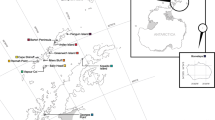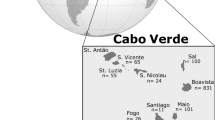Abstract
The common seadragon is an iconic fish with presumed limited dispersal, because juveniles hatch directly from the tail of the male parent. Nothing is presently known of their phylogeographic structure, despite conservation concerns and a distribution spanning southern Australia. Here, we sequenced mitochondrial genes from 201 common seadragons in Western Australia, South Australia, Victoria, Tasmania and New South Wales. We show that common seadragon populations are highly structured geographically, and that genetic variation varies significantly. The historical Bassian Isthmus appears to have left a strong imprint on population structure. Populations east of the Bassian Isthmus are low in diversity and appear more connected than those in the west, although this is likely caused by a recent expansion from a common source after the Last Glacial Maximum. All individuals from Eden, Bicheno and Hobart are represented by only two haplotypes. Populations west of the Bassian Isthmus are more diverse, with the highest diversity indices shown by Western Australian and Spencer Gulf populations. A large sampling gap across the Great Australian Bight is yet to be resolved; the west versus east break here may be an artifact of this gap. Almost all sampled populations can be inferred to have limited gene flow among them, which has implications for recovery after local extinction. Populations thought to be in decline (Sydney, Hobart) showed low genetic diversity, which may make them vulnerable to further reductions.




Similar content being viewed by others
References
Baker J (2005) Dragon Search Public Report. Summary of South Australian Sighting Data, to May 2005. Consultancy report to Marine and Coastal Community Network and Threatened Species Network, for Dragon Search Community-Based Monitoring Program, South Australia. 60 pp, 10 maps
Bird CE, Holland BS, Bowen BW, Toonen RJ (2007) Contrasting phylogeography in three endemic Hawaiian limpets (Cellana spp.) with similar life histories. Mol Ecol 16:3173–3186
Brown LD (1991) Genetic variation and population stucture in the blacklip abalone, Haliotis rubra. Mar Freshwater Res 42:77–90
Charlton-Robb K, Taylor AC, McKechnie SW (2015) Population genetic structure of the Burrunan dolphin (Tursiops australis) in coastal waters of south-eastern Australia: conservation implications. Conserv Genet 16:195–207
Colgan DJ, Paxton JR (1997) Biochemical genetics and recognition of a western stock of the common gemfish, Rexea solandri (Scombroidea: Gempylidae), in Australia. Mar Freshwater Res 48:103–118
Colgan DJ, Schreiter S (2011) Extrinsic and intrinsic influences on the phylogeography of the Austrocochlea constricta species group. J Exp Mar Biol Ecol 397:44–51
Connolly R (2006) Phyllopteryx taeniolatus. The IUCN red list of threatened species 2006. Version 2015.4. Downloaded on 24 January 2016
Connolly RM, Melville AJ, Preston K (2002) Patterns of movement and habitat use by leafy seadragons tracked ultrasonically. J Fish Biol 61:684–695
Currie DR, Dixon CD, Roberts SD, Hooper GE, Sorokin SJ, Ward TM (2009) Fishery-independent by-catch survey to inform risk assessment of the Spencer Gulf Prawn Trawl Fishery Report to PIRSA Fisheries. South Australian Research and Development Institute (Aquatic Sciences) Publication No. F2009/000369-1. SARDI Research Report Series No. 390, Adelaide, p 121
Darriba D, Taboada GL, Doallo R, Posada D (2012) jModelTest 2: more models, new heuristics and parallel computing. Nat Methods 9:772
Dawson MN (2005) Incipient speciation of Catostylus mosaicus (Scyphozoa, Rhizostomeae, Catostylidae), comparative phylogeography and biogeography in south-east Australia. J Biogeo 32:515–533
DiBattista JD, Randall JE, Newman SJ, Bowen BW (2014) Round herring (genus Etrumeus) contain distinct evolutionary lineages coincident with a biogeographic barrier along Australia’s southern temperate coastline. Mar Biol 161:2465–2477
Drew JA, Barber PH (2012) Comparative phylogeography in Fijian coral reef fishes: a multi-taxa approach towards marine reserve design. PLoS One: e47710
Edyvane KS (1999) Conserving Marine Biodiversity in South Australia, Part 1 –Background, status and review of approach to marine biodiversity in South Australia.SARDI. South Australia
Excoffier L, Laval G, Schneider S (2005) Arlequin (version 3.0): an integrated software package for population genetics data analysis. Evol Bioinform Online 1:47–50
Fraser CI, Spencer HG, Waters JM (2009) Glacial oceanographic contrasts explain phylogeography of Australian bull kelp. Mol Ecol 18:2287–2296
Fu YX (1997) Statistical tests of neutrality of mutations against population growth, hitchhiking and background selection. Genetics 147:915–925
Golding RE, Colgan DJ, Nelmes G, Reutelshöfer T (2011) Sympatry and allopatry in the deeply divergent mitochondrial DNA clades of the estuarine pulmonate gastropod genus Phallomedusa (Mollusca, Gastropoda). Mar Biol 158:1259–1269
Hails JR, Belperio AP, Gostin VA (1984) Quaternary sea levels, northern Spencer Gulf, Australia. Mar Geol 61:373–389
Hrbek T, Farias IP (2008) The complete mitochondrial genome of the pirarucu (Arapaima gigas, Arapaimidae, Osteoglossiformes). Genet Mol Biol 31:293–302
Inoue JG, Miya M, Tsukamoto K, Nishida M (2003) Evolution of the deep-sea gulper eel mitochondrial genomes: large-scale gene rearrangements originated within the eels. Mol Biol Evol 20:1917–1924
Katoh K, Standley DM (2013) MAFFT multiple sequence alignment software version 7: improvements in performance and usability. Mol Biol Evol 30:772–780
Katoh K, Misawa K, Kuma KI, Miyata T (2002) MAFFT: a novel method for rapid multiple sequence alignment based on fast Fourier transform. Nuc Acids Res 30:3059–3066
Kirkman H (1997) Seagrasses of Australia. Australia: State of the Environment Technical Paper Series (Estuaries and the Sea). Canberra, Australia
Knight M, Vainickis A (2011) Interactions with Threatened, Endangered or Protected Species in South Australian managed fisheries-2008/9, 2009/10 and 2010/11. Report to PIRSA Fisheries and Aquaculture, Henley Beach, South Australia
Kuiter RH (2000) Seahorses, pipefishes and their relatives. TMC Publishing, Chorleywood
Lambeck K, Chappell J (2001) Sea level change through the last glacial cycle. Science 292:679–686
Leigh JW, Bryant D (2015) Popart: full-feature software for haplotype network construction. Methods Ecol Evol 6:1110–1116
Liu Z, Liu G, Roos C, Wang Z, Xiang Z, Zhu P, Wang B, Ren B, Shi F, Pan H, Li M (2015) Implications of genetics and current protected areas for conservation of 5 endangered primates in China. Conserv Biol 29:1508–1517
Luzzatto DC, Estalles ML, Diaz de Astarloa JM (2013) Rafting seahorses: the presence of juvenile Hippocampus patagonicus in floating debris. J Fish Biol 83:677–681
Maddison WP, Maddison DR (2011) Mesquite: a modular system for evolutionary analysis. Version 2.75. Available at: http://mesquiteproject.org/mesquiteArchives/mesquite2.75/index.html
Martin-Smith KM (2011) Photo-identification of individual weedy seadragons Phyllopteryx taeniolatus and its application in estimating population dynamics. J Fish Biol 78:1757–1768
Martin-Smith KM, Vincent ACJ (2006) Exploitation and trade of Australian seahorses, pipehorses, sea dragons and pipefishes (family Syngnathidae). Oryx 40:141–151
Meyer A, Morrissey JM, Schartl M (1994) Recurrent origin of a sexually selected trait in Xiphophorus fishes inferred from a molecular phylogeny. Nature 368:539–542
Miller AD, Versace VL, Matthews TG, Montgomery S, Bowie KC (2013) Ocean currents influence the genetic structure of an intertidal mollusc in southeastern Australia–implications for predicting the movement of passive dispersers across a marine biogeographic barrier. Ecol Evol 3:1248–1261
Miya M, Nishida M (1999) Organization of the mitochondrial genome of a deep-sea fish, Gonostoma gracile (Teleostei: Stomiiformes): first example of transfer RNA gene rearrangements in bony fishes. Mar Biotechnol 1:416–426
Mobley KB, Small CM, Jones AG (2011) The genetics and genomics of Syngnathidae: pipefishes, seahorses and seadragons. J Fish Biol 78:1624–1646
Moore GI, Chaplin JA (2014) Contrasting demographic histories in a pair of allopatric, sibling species of fish (Arripidae) from environments with contrasting glacial histories. Mar Biol 161:1543–1555
Moritz C (1994) Defining ‘evolutionarily significant units’ for conservation. TREE 9:373–375
Palumbi SR (1997) Molecular biogeography of the Pacific. Coral Reefs 16:S47–S52
Palumbi SR (2003) Population genetics, demographic connectivity, and the design of marine reserves. Ecol Appl 13:146–158
Paradis E (2010) Pegas: An R package for population genetics with an integrated-modular approach. Bioinform 26:419–420
Pogonoski JJ, Pollard DA, Paxton JR (2002) Conservation overview and action plan for Australian threatened and potentially threatened marine and estuarine fishes. Environment Australia
Purwandana D, Ariefiandy A, Imansyah MJ, Rudiharto H, Seno A, Ciofi C, Fordham DA, Jessop TS (2014) Demographic status of Komodo dragons populations in Komodo National Park. Biol Conserv 171:29–35
Ridgway KR (2007) Long-term trend and decadal variability of the southward penetration of the East Australian Current. Geophys Res Lett 34:L13613
Rogers AR, Harpending H (1992) Population growth makes waves in the distribution of pairwise genetic differences. Mol Biol Evol 9:552–569
Sanchez-Camara J, Booth DJ (2004) Movement, home range and site fidelity of the Weedy Seadragon Phyllopteryx taeniolatus (Teleostei: Syngnathidae). Environ Biol Fishes 70:31–41
Sanchez-Camara J, Booth DJ, Turon X (2005) Reproductive cycle and growth of Phyllopteryx taeniolatus. J Fish Biol 67:133–148
Sanchez-Camara J, Martin-Smith K, Booth D, Fritschi J, Turon X (2011) Demographics and vulnerability of a unique Australian fish, the weedy seadragon Phyllopteryx taeniolatus. Mar Ecol Prog Ser 422:253–264
Scales H (2010) Advances in the ecology, biogeography and conservation of seahorses (genus Hippocampus). Prog Phys Geogr 34:443–458
Sorokin SJ, Connolly RM, Currie DR (2009) Syngnathids of the Spencer Gulf-morphometrics and isotope signatures. Report to Nature Foundation SA Inc. South Australian Research and Development Institute (SARDI), Adelaide
Stamatakis A (2006) RAxML-VI-HPC: Maximum likelihood-based phylogenetic analyses with 457 thousands of taxa and mixed models. Bioinform 22:2688–2690
Stiller J, Wilson NG, Rouse GW (2015) A spectacular new species of seadragon (Syngnathidae). R Soc Open Sci 2:140458
Sun C, Feng M, Matear RJ, Chamberlain MA, Craig P, Ridgway KR, Schiller A (2012) Marine downscaling of a future climate scenario for Australian boundary currents. J Climate 25:2947–2962
Swofford D (2002) PAUP*. Phylogenetic Analysis Using Parsimony (*and other methods). Version 4. Sunderland, MA: Sinauer Associates
Teske PR, Hamilton H, Palsbøll PJ, Choo CK, Gabr H, Lourie SA, Santos M, Sreepada A, Cherry MI, Matthee CA (2005) Molecular evidence for long-distance colonization in an Indo-Pacific seahorse lineage. Mar Ecol Prog Ser 286:249–260
Vincent ACJ (1996) The international trade in seahorses. Traffic International, Cambridge, UK
Vincent ACJ, Foster SJ, Koldewey HJ (2011) Conservation and management of seahorses and other Syngnathidae. J Fish Biol 78:1681–1724
Walker DI, McComb AJ (1992) Seagrass degradation in Australian coastal waters. Mar Pollut Bull 25:191–195
Warnes GR, Bolker B, Bonebakker L, et al (2015) gplots: Various R Programming Tools for Plotting Data
Waters JM (2008) Marine biogeographical disjunction in temperate Australia: historical landbridge, contemporary currents, or both? Divers Distrib 14:692–700
Waters JM, Roy MS (2003) Marine biogeography of southern Australia: phylogeographical structure in a temperate sea-star. J Biogeogr 30:1787–1796
Waters JM, O’Loughlin PM, Roy MS (2004) Cladogenesis in a starfish species complex from southern Australia: evidence for vicariant speciation? Mol Phylo Evo 32:236–245
Waycott M, Duarte CM, Carruthers TJ, Orth RJ, Dennison WC, Olyarnik S, Calladine A, Fourqurean JW, Heck KL, Hughes AR, Kendrick GA (2009) Accelerating loss of seagrasses across the globe threatens coastal ecosystems. Proc Natl Acad Sci USA 106:12377–12381
Wernberg T, Russell BD, Thomsen MS, Gurgel C, Frederico D, Bradshaw CJA, Poloczanska ES, Connell SD (2011) Seaweed communities in retreat from ocean warming. Curr Biol 21:1828–1832
York KL, Blacket MJ, Appleton BR (2008) The Bassian Isthmus and the major ocean currents of southeast Australia influence the phylogeography and population structure of a southern Australian intertidal barnacle Catomerus polymerus (Darwin). Mol Ecol 17:1948–1961
Acknowledgments
We thank our funders National Geographic and the Lowe Family Foundation. Additional samples were collected in studies funded by Spencer Gulf and West Coast Prawn Fishermans Association (SGWCPFA), and carried out by SGWCPFA, South Australian Research and Development Institute Aquatic Sciences (SARDI), and Primary Industry and Regions SA Fisheries, made available by SA Museum. Tony Wilson gave helpful advice on primer selection. We also thank Mindi Summers, Anke Klueter, Michael Kong, Nick Yee, Steve Donnellan (SAM), Shirley Sorokin (SARDI), Ralph Foster (SAM), Craig Lebens (Bremer Bay Dive), Sue Morrison (WAM), Glenn Moore (WAM) and Leslee Matsushige (Birch Aquarium at Scripps) for assistance with accessing or collecting samples. We also thank two anonymous reviewers for improving the manuscript.
Author information
Authors and Affiliations
Corresponding author
Additional information
Nerida G. Wilson and Josefin Stiller contributed equally.
Electronic supplementary material
Below is the link to the electronic supplementary material.
Rights and permissions
About this article
Cite this article
Wilson, N.G., Stiller, J. & Rouse, G.W. Barriers to gene flow in common seadragons (Syngnathidae: Phyllopteryx taeniolatus). Conserv Genet 18, 53–66 (2017). https://doi.org/10.1007/s10592-016-0881-y
Received:
Accepted:
Published:
Issue Date:
DOI: https://doi.org/10.1007/s10592-016-0881-y




